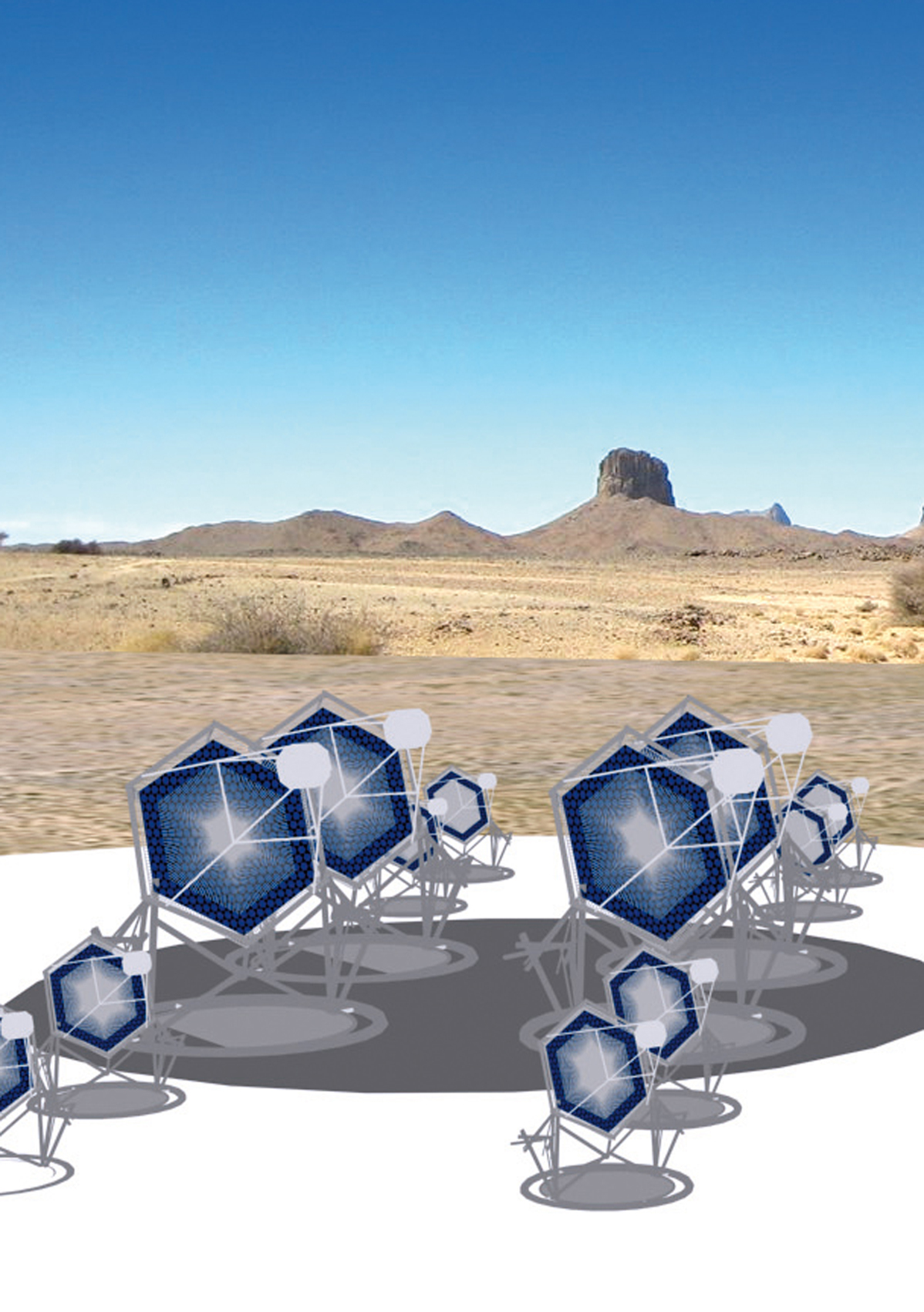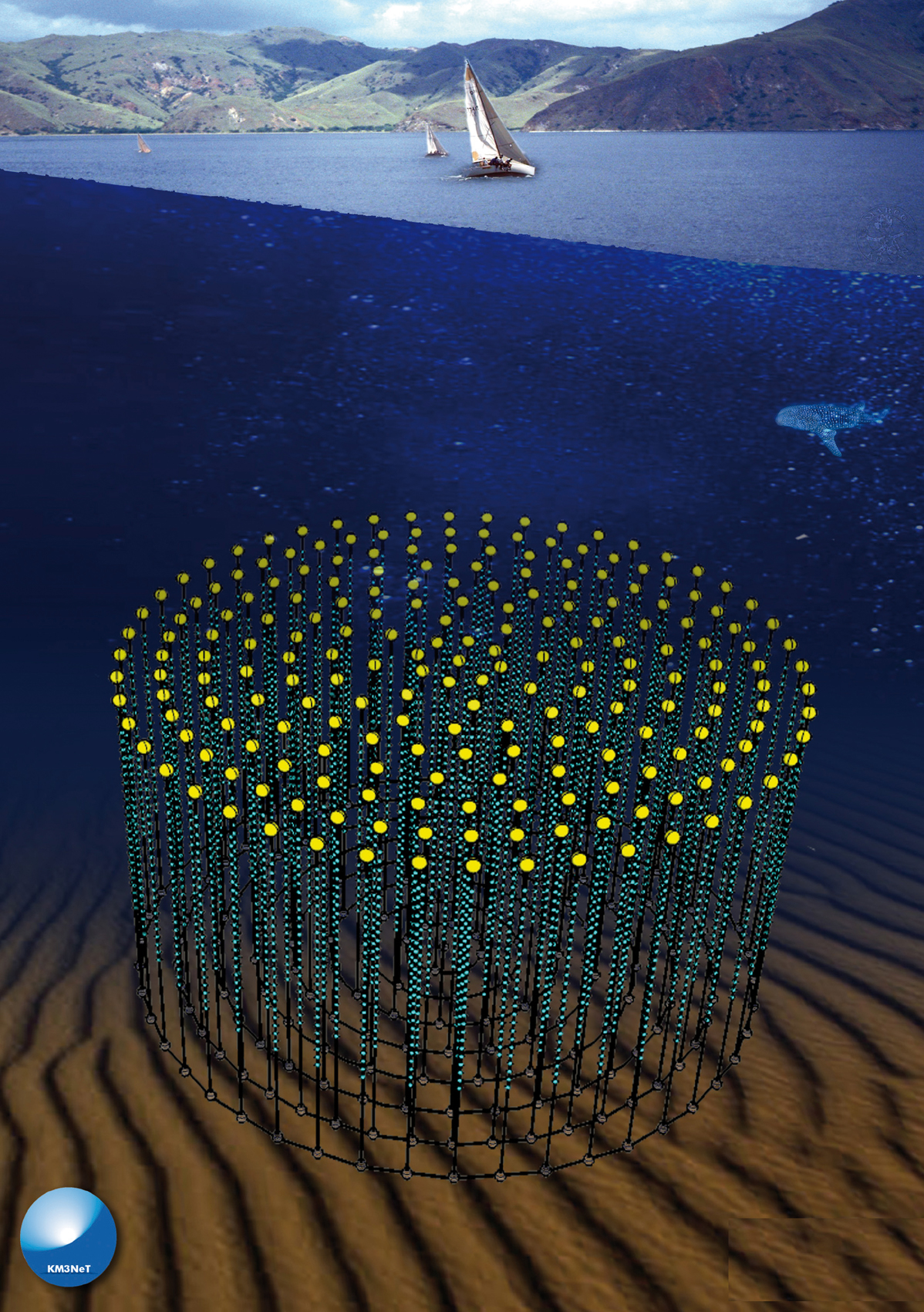Astroparticle physics gets organized!
Astroparticle physics is a rapidly growing field of research at the intersection of astrophysics, particle physics and cosmology. But unlike particle physics it has no permanent organizations like CERN to plan for the long-term future. But this is starting to change, and CERN may be able to help.
Two proposed new astroparticle physics experiments. The Cherenkov Telescope Array (CTA) (above) and KM3NeT, a neutrino telescope in the mediterranean sea (below).
Founded just three years ago, ASPERA, the European network for astroparticle physics, is a temporary organization whose aim is to promote co-operation and co-ordination in a field which has never before had a uniting body. Several years of intensive work by the roadmap committee has resulted in a ‘European strategy for astroparticle physics’ which was announced at the ASPERA meeting in Brussels on 29-30 September 2008. As well as plans for new infrastructures, the document highlights proposals for seven huge new experiments.
Dubbed the "Magnificent Seven", these include CTA, a large array of Cherenkov Telescopes for detection of cosmic high-energy gamma rays and KM3NeT, a cubic kilometre-scale neutrino telescope in the Mediterranean Sea. These multi-hundred-million euro proposals will require international collaboration between many countries and institutions. But as well as greater co-operation within the astroparticle community, ASPERA also hopes for more involvement with the particle physics community, a goal that is shared here at CERN.
"I believe we should think more globally in our experiments and more globally in where we define our boundaries to other scientific areas," said Rolf Heuer, Director-General elect of CERN. "Of course, the primary role of CERN is accelerator-based particle physics, but I believe that particle physics and astroparticle physics should work more closely together and CERN could play an important role in this."
To help integrate CERN with astroparticle physics, Maurice Bourquin, Chairman of the ASPERA Governing Board, and former President of the CERN Council, has been newly appointed as the astroparticle physics representative to the CERN Council. It will be the first time the CERN Council strategy sessions will have a spokesperson specifically for astroparticle physics. Perhaps unsurprisingly, Bourquin hopes for CERN to become much more involved with astroparticle physics.
"One could define astroparticle physics as using the tools of particle physics, such as detectors, to look at objects in the cosmos," explained Bourquin. "But it is also true in the reverse – we can use objects in the cosmos to learn about particle physics. Ultimately we are working towards the same scientific goals."
Particle physics, astrophysics and cosmology have always been intertwined. For Bourquin astroparticle physics is a way to unite these different areas of physics theory and research. "Cosmology and particle physics are described by models that scientists have been trying to unite for many years. If you think of particle physics, you think of the Standard Model, and if you think of cosmology, you think of gravitation. But it is clear that there is only one truth, one fundamental physics, so they both must work from the same physical laws. Astroparticle physics has the advantage of being at the intersection of these disciplines."
"I think once we realise this we should do something to help co-ordinate astroparticle physics and bring it closer to the accelerator community," he added. "But of course the next question is how do we do this? Perhaps is it only a network of countries or agencies or possibly it is integrating into a lab in Europe that could host such activities. Or could we build an international organization, much like CERN has for particle physics? Well this is what we will be discussing at ASPERA in the coming years."
CERN has already been able to increase its participation in astroparticle physics by creating the status of ‘recognised experiment’ for projects such as AMS, ANTARES, Auger, CAST, IceCube, etc. In fact, nearly all of the CERN recognised experiments could be classed as astroparticle physics. "But I think CERN is capable of something more ambitious" said Bourquin. "A very achievable goal would be to provide the recognised experiments with a structure that would allow them to communicate with each other, and to share data and expertise. Not only this, but it could also provide an opportunity to easily communicate between the worlds of astroparticle physics and particle physics."
Whilst these proposals are at a very early stage of development, the ideas have been set in motion. Whether these new infrastructures are located at CERN, or simply modelled on CERN’s international structure, it is clear that in the coming years we are likely to see much greater co-operation both within the astroparticle physics community, and between astroparticle and particle physics. ASPERA, whose temporary contract will end in 2009, will be replaced by ASPERA2, which will run for another 3 years and continue to plan for the future of astroparticle physics in Europe.
For more information on ASPERA or to download a copy of the European strategy for astroparticle physics please visit:
A home for astroparticle theory
Creating an organization to share ideas is arguably even more crucial for astroparticle theory, where the boundaries between the different fields are even more blurred. "Most theorists have interests that go beyond one experiment, and this is especially true for astroparticle physics which is very interdisciplinary," said Subir Sarkar, an astroparticle theorist at Oxford University and member of the roadmap committee who is also involved in astroparticle experiments. "I am concerned that there is often a feeling that theorists don’t need much support beyond chalk and a blackboard!" he added. "There is a clear need for a physical centre where astroparticle theorists can meet and interact, a place not just to analyse present data but to think ahead and envision the future."
Proposals have already been made by ASPERA for a future European Centre for Astroparticle Theory, and CERN is one of the possible locations. In fact, the recent ASPERA strategy report said that: "Given the synergy between LHC physics and astroparticle physics, CERN would be a natural host, particularly in view of several astroparticle experiments being CERN recognised experiments."
"My personal preference is for CERN," agreed Subir Sarkar, "not just because there are already CERN theorists involved in astroparticle physics and several CERN recognized astroparticle experiments, but also because it has the right atmosphere - at CERN you really feel like you are contributing to a truly international endeavour."



